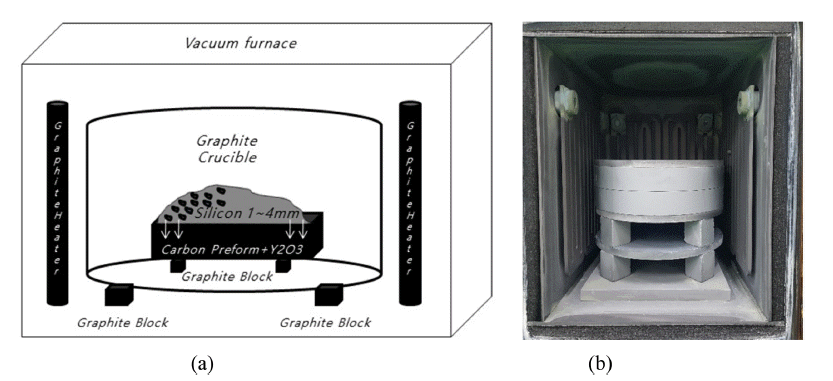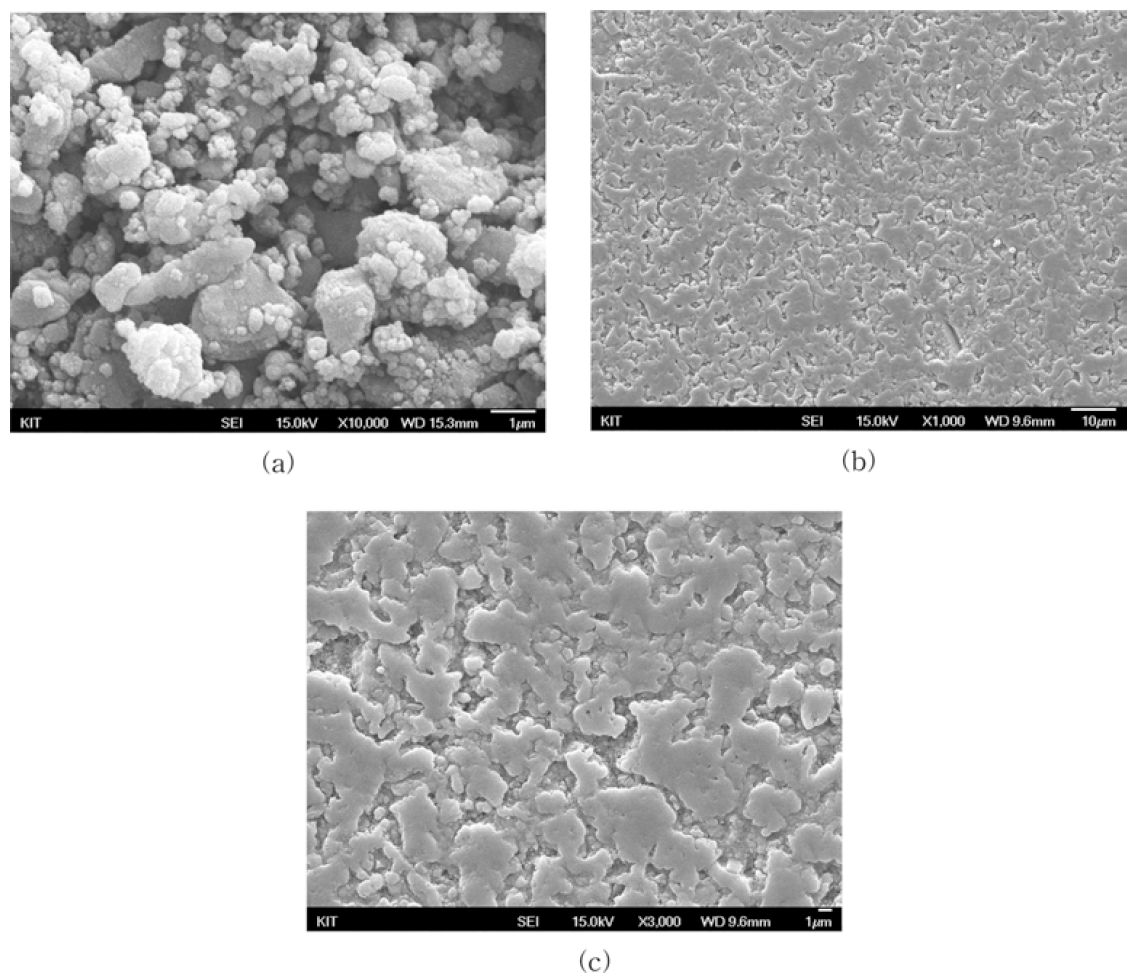Search
- Page Path
- HOME > Search
- [Korean]
- RBSC Prepared by Si Melt Infiltration into the Y2O3 Added Carbon Preform
- Min-Ho Jang, Kyeong-Sik Cho
- J Korean Powder Metall Inst. 2021;28(1):51-58. Published online February 1, 2021
- DOI: https://doi.org/10.4150/KPMI.2021.28.1.51

- 1,127 View
- 12 Download
-
 Abstract
Abstract
 PDF
PDF The conversion of carbon preforms to dense SiC by liquid infiltration is a prospectively low-cost and reliable method of forming SiC-Si composites with complex shapes and high densities. Si powder was coated on top of a 2.0wt .% Y2O3-added carbon preform, and reaction bonded silicon carbide (RBSC) was prepared by infiltrating molten Si at 1,450°C for 1-8 h. Reactive sintering of the Y2O3-free carbon preform caused Si to be pushed to one side, thereby forming cracking defects. However, when prepared from the Y2O3-added carbon preform, a SiC-Si composite in which Si is homogeneously distributed in the SiC matrix without cracking can be produced. Using the Si + C → SiC reaction at 1,450°C, 3C and 6H SiC phases, crystalline Si, and Y2O3 were generated based on XRD analysis, without the appearance of graphite. The RBSC prepared from the Y2O3-added carbon preform was densified by increasing the density and decreasing the porosity as the holding time increased at 1,450°C. Dense RBSC, which was reaction sintered at 1,450°C for 4 h from the 2.0wt.% Y2O3-added carbon preform, had an apparent porosity of 0.11% and a relative density of 96.8%.
- [Korean]
- Multicomponent IGZO Ceramics for Transparent Electrode Target Fabricated from Oxides and Nitrates
- Hyun-Kwun Lee, Ji-Hye Yoon, Kyeong-Sik Cho
- J Korean Powder Metall Inst. 2019;26(5):375-382. Published online October 1, 2019
- DOI: https://doi.org/10.4150/KPMI.2019.26.5.375

- 454 View
- 1 Download
-
 Abstract
Abstract
 PDF
PDF Homogeneous multicomponent indium gallium zinc oxide (IGZO) ceramics for transparent electrode targets are prepared from the oxides and nitrates as the source materials, and their properties are characterized. The selected compositions were In2O3:Ga2O3:ZnO = 1:1:2, 1:1:6, and 1:1:12 in mole ratio based on oxide. As revealed by X-ray diffraction analysis, calcination of the selected oxide or nitrides at 1200°C results in the formation of InGaZnO4, InGaZn3O6, and InGaZn5O8 phases. The 1:1:2, 1:1:6, and 1:1:12 oxide samples pressed in the form of discs exhibit relative densities of 96.9, 93.2, and 84.1%, respectively, after sintering at 1450°C for 12 h. The InGaZn3O6 ceramics prepared from the oxide or nitrate batches comprise large grains and exhibit homogeneous elemental distribution. Under optimized conditions, IGZO multicomponent ceramics with controlled phases, high densities, and homogeneous microstructures (grain and elemental distribution) are obtained.
- [Korean]
- Consolidation to Bulk Ceramic Bodies from Oyster Shell Powder
- Kyeong-Sik Cho, Hyun-Kwuon Lee, Jae Hong Min
- J Korean Powder Metall Inst. 2016;23(3):221-227. Published online June 1, 2016
- DOI: https://doi.org/10.4150/KPMI.2016.23.3.221

- 1,263 View
- 9 Download
-
 Abstract
Abstract
 PDF
PDF Waste oyster shells create several serious problems; however, only some parts of them are being utilized currently. The ideal solution would be to convert the waste shells into a product that is both environmentally beneficial and economically viable. An experimental study is carried out to investigate the recycling possibilities for oyster shell waste. Bulk ceramic bodies are produced from the oyster shell powder in three sequential processes. First, the shell powder is calcined to form calcium oxide CaO, which is then slaked by a slaking reaction with water to produce calcium hydroxide Ca(OH)2. Then, calcium hydroxide powder is formed by uniaxial pressing. Finally, the calcium hydroxide compact is reconverted to calcium carbonate via a carbonation reaction with carbon dioxide released from the shell powder bed during firing at 550°C. The bulk body obtained from waste oyster shells could be utilized as a marine structural porous material.
- [Korean]
- Effect of Sintering Temperature on Microstructure and Mechanical Properties for the Spark Plasma Sintered Titanium from CP-Ti Powders
- Kyeong-Sik Cho, In-Beom Song, Min-Hyeok Jang, Ji-Hye Yoon, Myung-Hoon Oh, Jae-Keun Hong, Nho-Kwang Park
- J Korean Powder Metall Inst. 2010;17(5):365-372.
- DOI: https://doi.org/10.4150/KPMI.2010.17.5.365

- 713 View
- 6 Download
- 7 Citations
-
 Abstract
Abstract
 PDF
PDF - The evolution of sinterability, microstructure and mechanical properties for the spark plasma sintered(SPS) Ti from commercial pure titanium(CP-Ti) was studied. The densification of titanium with 200 mesh and 400 mesh pass powder was achieved by SPS at 750sim1100°C under 10 MPa pressure and the flowing H_2+Ar mixed gas atmosphere. The microstructure of Ti sintered up to 800°C consisted of equiaxed grains. In contrast, the growth of large elongated grains was shown in sintered bodies at 900°C with the 400 mesh pass powder and the lamella grains microstructure had been developed by increasing sintering temperature. The Vickers hardness of 240~270 HV and biaxial strength of 320~340 MPa were found for the specimen prepared at 950°C.
-
Citations
Citations to this article as recorded by- Sintering pressure effect on the performances of near-zero thermal expansion xLFCS/Cu metal matrix composites
Chang Zhou, Hong Zhong, Hao Lu, Xuelu Pang, Congfa Zhang, Haowu Wang, Qiang Cong, Yuzhu Song, Naike Shi, Jiong Zhao, Xiangxu Meng, Jun Chen
Ceramics International.2023; 49(17): 27958. CrossRef - Spark plasma sintered Al-0.5 wt% MWCNT nanocomposite: Effect of sintering pressure on the densification behavior and multi-scale mechanical properties
Lavish K. Singh, Alok Bhadauria, Akash Oraon, Tapas Laha
Diamond and Related Materials.2019; 91: 144. CrossRef - Manufacturing and Properties of CGI-based Composite Coating Layer Utilizing a Warm Spray Process and Cu-Ga and Cu-In Mixed Powders
Min-Gwang Jeon, Myeong-Ju Lee, Hyeong-Jun Kim, Kee-Ahn Lee
Journal of Korean Powder Metallurgy Institute.2014; 21(3): 229. CrossRef - Effect of particle size distribution on microstructure and mechanical properties of spark-plasma-sintered titanium from CP-Ti powders
Je Ha Shon, In-Beom Song, Kyeong-Sik Cho, Yong-il Park, Jae-Keun Hong, Nho-Kwang Park, Myung-Hoon Oh
International Journal of Precision Engineering and Manufacturing.2014; 15(4): 643. CrossRef - Effects of various sintering methods on microstructure and mechanical properties of CP-Ti powder consolidations
Je-ha SHON, Jong-moon PARK, Kyeong-sik CHO, Jae-keun HONG, Nho-kwang PARK, Myung-hoon OH
Transactions of Nonferrous Metals Society of China.2014; 24: s59. CrossRef - Sintering and Rolling Behavior of Cu-50In-13Ga Ternary Alloy Powder for Sputtering Target
Dae-Won Kim, Yong-Ho Kim, Jung-Han Kim, Dae-Guen Kim, Jong-Hyeon Lee, Kwang-Bo Choi, Hyeon-Taek Son
Journal of Korean Powder Metallurgy Institute.2012; 19(4): 264. CrossRef - Effect of Heat Treatment Environment on the Properties of Cold Sprayed Cu-15 at.%Ga Coating Material for Sputtering Target
Byung-Chul Choi, Dong-Yong Park, Hyung-Jun Kim, Ik-Hyun Oh, Kee-Ahn Lee
Journal of Korean Powder Metallurgy Institute.2011; 18(6): 552. CrossRef
- Sintering pressure effect on the performances of near-zero thermal expansion xLFCS/Cu metal matrix composites
- [Korean]
- Influence of α-SiC Seed Addition on Spark Plasma Sintering of β-SiC with Al-B-C: Microstructural Development
- Kyeong-Sik Cho, Hyun-Kwuon Lee, Sang-Woo Lee
- J Korean Powder Metall Inst. 2010;17(1):13-22.
- DOI: https://doi.org/10.4150/KPMI.2010.17.1.013

- 618 View
- 0 Download
- 1 Citations
-
 Abstract
Abstract
 PDF
PDF - The unique features of spark plasma sintering process are the possibilities of a very fast heating rate and a short holding time to obtain fully dense materials. beta-SiC powder with 0, 2, 6, 10 wt% of alpha-SiC particles (seeds) and 4 wt% of Al-B-C (sintering aids) were spark plasma sintered at 1700-1850°C for 10 min. The heating rate, applied pressure and sintering atmosphere were kept at 100°C/min, 40 MPa and a flowing Ar gas (500 CC/min). Microstructural development of SiC as function of seed content and temperature during spark plasma sintering was investigated quantitatively and statistically using image analysis. Quantitative image analyses on the sintered SiC ceramics were conducted on the grain size, aspect ratio and grain size distribution of SiC. The microstructure of SiC sintered up to 1700°C consisted of equiaxed grains. In contrast, the growth of large elongated SiC grains in small matrix grains was shown in sintered bodies at 1750°C and the plate-like grains interlocking microstructure had been developed by increasing sintering temperature. The introduction of alpha-SiC seeds into beta-SiC accelerated the grain growth of elongated grains during sintering, resulting in the plate-like grains interlocking microstructure. In the alpha-SiC seeds added in beta-SiC, the rate of grain growth decreased with alpha-SiC seed content, however, bulk density and aspect ratio of grains in sintered body increased.
-
Citations
Citations to this article as recorded by- Effect of Sintering Temperature on Microstructure and Mechanical Properties for the Spark Plasma Sintered Titanium from CP-Ti Powders
Kyeong-Sik Cho, In-Beom Song, Min-Hyeok Jang, Ji-Hye Yoon, Myung-Hoon Oh, Jae-Keun Hong, Nho-Kwang Park
Journal of Korean Powder Metallurgy Institute.2010; 17(5): 365. CrossRef
- Effect of Sintering Temperature on Microstructure and Mechanical Properties for the Spark Plasma Sintered Titanium from CP-Ti Powders
- [Korean]
- Thermal Stability of Al-Fe-X Alloy System Prepared by Mechanical Alloying and Spark Plasma Sintering: I. Al-Fe
- Hyun-Kwuon Lee, Sang-Woo Lee, Kyeong-Sik Cho
- J Korean Powder Metall Inst. 2005;12(1):70-78.
- DOI: https://doi.org/10.4150/KPMI.2005.12.1.070

- 727 View
- 0 Download
- 1 Citations
-
 Abstract
Abstract
 PDF
PDF - Mechanical alloying using high-energy ball mill and subsequent spark plasma sintering (SPS) process was applied to understand mechanical alloying processing of Al-Fe alloy system. The thermal stability of mechanically alloyed Al-Fe alloy was intended to be enhanced by SPS process. Various analytical techniques including particle size analysis, density measurement, micro-Vickers hardness test, SEM, TEM, and X-ray diffractometry were adopted to find optimum processing conditions for mechanical alloying and subsequent SPS and to estimate thermal stability of the prepared alloy. It was found from the treatment of mechanically alloyed Al-8wt.%Fe powder mixture that needle-shaped Al_3Fe precipitates was formed in the Al-Fe matrix, and the alloy compact showed enhanced densification and reached its full density with little loss of its fine microstructure. After heat treatment at 500circC, it was also shown that the thermal stability of Al-8wt.%Fe alloy fabricated in the present study was enhanced, which was due to its fine microstructure developed by fast densification of SPS.
-
Citations
Citations to this article as recorded by- Effect of Sintering Temperature on Microstructure and Mechanical Properties for the Spark Plasma Sintered Titanium from CP-Ti Powders
Kyeong-Sik Cho, In-Beom Song, Min-Hyeok Jang, Ji-Hye Yoon, Myung-Hoon Oh, Jae-Keun Hong, Nho-Kwang Park
Journal of Korean Powder Metallurgy Institute.2010; 17(5): 365. CrossRef
- Effect of Sintering Temperature on Microstructure and Mechanical Properties for the Spark Plasma Sintered Titanium from CP-Ti Powders
- [Korean]
- Thermal Stability of Al-Fe-X Alloy System Prepared by Mechanical Alloying and Spark Plasma Sintering: II. Al-Fe-Cr and Al-Fe-Mo
- Hyun-Kwuon Lee, Sang-Woo Lee, Kyeong-Sik Cho
- J Korean Powder Metall Inst. 2005;12(1):43-50.
- DOI: https://doi.org/10.4150/KPMI.2005.12.1.043

- 657 View
- 1 Download
- 1 Citations
-
 Abstract
Abstract
 PDF
PDF - Mechanical alloying using high-energy ball mill and subsequent spark plasma sintering (SPS) process was applied to Al-Fe-Cr and Al-Fe-Mo powder mixture to investigate effects of Cr and Mo addition on thermal stability of Al-Fe, and thereby to enhance its thermal stability up to 500circC. Various analytical techniques including micro-Vickers hardness test, SEM, TEM, X-ray diffractometry and corrosion test were carried out. It was found that addition of Cr and Mo to Al-Fe system played a role of grain growth inhibitor of matrix Al and some precipitates such as Al_3Fe during SPS and subsequent heat treatment. The inhibition of grain growth resulted in increased Vickers hardness and thermal stability up to 500circC comparing to those of Al-Fe alloy system.
-
Citations
Citations to this article as recorded by- A Constitutional Framework of a Future Palestinian State - Synthesis of Leading Palestinian Thinking and Public Perceptions
Asem Khalil
SSRN Electronic Journal.2009;[Epub] CrossRef
- A Constitutional Framework of a Future Palestinian State - Synthesis of Leading Palestinian Thinking and Public Perceptions
TOP
 KPMI
KPMI


 First
First Prev
Prev


